Abstract
To successfully deal with emergent events or crises, it is necessary to have a fully planned integrated rescue system (IRS). The stages of the IRS are tested by exercises that aim to model rescue and clean-up operations as closely as possible. This article compares different software tools to support the creation and implementation of exercises of different stages of the IRS. The article aims to compare suitable software tools and evaluate their application in the individual phases of creating tactical exercises in the IRS and application to the implementation and evaluation phase. Methods of explanation, comparison, and modeling are used to achieve the goals. It was found that the investigated software programmes are all suitable for use in the organization of exercises. The results are shown in a comparison table and examples of individual model situations. The article presents possible implementation scenarios of software tools for creating and organizing exercises of stages of the IRS, which can make the preparation of both tactical and screening exercises more efficient.
1. Introduction
The parameters of the integrated rescue system (IRS) are set out and defined in Act No. 239/2000 Coll. This law defines the IRS as “A coordinated procedure of its components in preparing for emergencies and in carrying out rescue and liquidation work”. The tasks that are performed during the rescue work also depend on the tasks required to protect the population [1]. Vichova et al. [2] list among these tasks as, the coordination of evacuation activities, emergency accommodation, and the necessary means for the survival of the population in emergencies and crises [3].
In the Czech Republic, the primary agencies and secondary agencies are distinguished from each other. The primary groups of the IRS include:
- Fire and Rescue Service of the Czech Republic;
- Fire protection units included in the area coverage of the region;
- Czech Republic Police;
- Providers of emergency medical services.
The secondary groups of the IRS include:
- Dedicated forces and resources of the armed forces;
- Municipal police;
- Public health authorities;
- Emergency, professional, and other services;
- Civil protection equipment;
- Non-profit organizations and citizen associations that can be used for rescue and liquidation work.
All these groups are involved in rescue and clean-up operations. Haddow, G.D. et al. [4] state in their book that there “is no country, community, or person immune to emergencies and disasters. However, with proper preparation, their effects can be mitigated”. Another of the selected authors who deal with population protection is Yusufalievich et al. [5].
For agility and readiness, it is necessary to undertake regular exercises. The IRS Act defines in §17 two types of exercises, namely tactical and verification exercises.
Tactical exercises of IRS units are exercises where the units are briefed in advance and examine the procedures and the management of the intervention. These exercises are always announced in advance and can be found in the publicly available materials of the fire brigade.
Verification exercises examine the ability to react and document the IRS. The difference from tactical exercises is that these exercises are not briefed in advance.
This research deals with tactical exercises and a comparison of programme tools that can be applied for their preparation and implementation. Exercises can be performed at the tactical, operational, and strategic levels and always consist of three phases:
- Preparatory;
- Implementation;
- Evaluation.
In order to not only save people, animals, property, and the environment but also to communicate and cooperate with the rescue and clean-up operation, it is necessary to plan and organize these exercises. Modern technologies or software equipment can also help to streamline processes and be able to deal with unforeseen events, meaning these exercises can be better planned [1,6]. As an example, we can mention the article by Li, F., dealing with modern trends in fire protection [7].
Current outputs in this area can be found in articles by Benda et al. [8] and Stanek et al. [9]. These articles bring exciting insights into crisis management support using modern technology. In these sources, the authors deal with issues close to our research. This article deals with the applicability of only one specific software and event. In contrast, this article compares several software programmes for planning and implementing exercises of components of an IRS within the crisis management framework.
According to available publications, an increase in the use of virtual reality technology can be observed in the exercises of the IRS. However, they mostly focus on either individual exercises or for only one component, such as the fire brigade or an emergency. As an example, we mention the publication by Çakıroğlu, Ü. and Seyfullah, G. [10], where the authors deal with the implementation of virtual reality in the exercise process of the fire rescue service, or by Guo, Y. et al. [11]. The article presents a simulation of evacuation using selected software (Pathfinder). An example is an article by Xu, L. et al. where the authors illustrate the procedure of evacuation with the help of the aforementioned programme [12]. The possibilities of presenting evacuation exercises are, in today’s age, also with the help of modern technologies. An example is an article by Yu, X. et al., which deals with the use of VR in the evacuation process [13].
The problem in this area is insufficient publication material or academic research, which are dedicated to supporting the exercises of the IRS. Strategic and conceptual materials are prepared in the Czech Republic which set goals for deepening experience and highlighting work with modern technologies. The foremost publication that sets these goals is the Population Protection Concept until 2025 with a view to 2030. The concept detailed in this publication is a relevant topic, which aims to indicate the possible use of software tools and modern technologies in the planning and implementation of exercises of the IRS [14].
The article focuses on the comparison of software tools in the exercise planning stages. Modern technologies that can be applied in the field during the implementation phase are mentioned as examples of use. Among the mentioned are virtual and augmented reality.
2. Materials and Methods
The research plan was divided by the authors into the following parts. In the first part of the research plan, the authors carried out a search and found out the necessity of this article. In the next part, applications were selected, which will be described in the article and applied to the IRS exercises. The TerEx (version 3.1.1), PRACTIS (version 1.0), and Pathfinder (version 2022.2.0803) applications were selected because of their easy user, financial, and local availability. The creation of examples and proposals for their solution, including the use of modern technologies, are described here. Their use is described in the individual stages of planning the exercises where they can be applied (Figure 1).
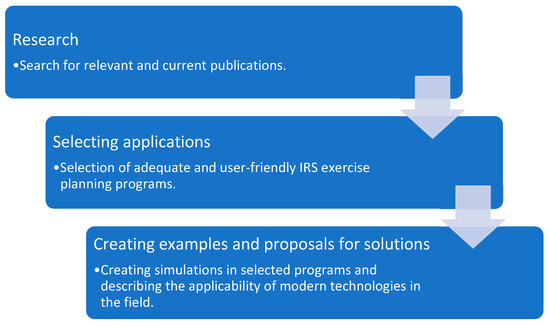
Figure 1.
Flowchart of the proposed methodology.
An example of a participant’s real-life emergency procedure was selected as a motivational scenario for the study. The trapped explosive system in the premises of the Faculty of Logistics and Crisis Management was selected as a threat. This event was simulated in the TerEx programme. Subsequently, using the PRACTIS programme, a scenario of the whole event was compiled, and the activities of the rescuers were described. Using the Pathfinder programme, evacuation from the premises of the building was realized. Thanks to these procedures, the coherence between the selected programmes and their applicability for planning exercises was proven. To fulfill the objectives of this article, the software applications TerEx, PRACTIS, and Pathfinder were selected for the preparatory phase of the IRS exercises. These programmes were selected for their accessibility and user experience. The programmes were tested on a computer equipped with Intel ® Core™ i7-9700 CPU @ (Santa Clara, CA, USA), 16 GB RAM (Fountain Valley, CA, USA), NVIDIA GeForce GTX 1660 SUPER (Santa Clara, CA, USA). Employees of the Department of Population Protection from Tomas Bata University in Zlin participated in the testing. To illustrate the usability, the same scenario was set in all software applications, namely, a trapped explosive system weighing 5 kg, and in the case of the Pathfinder, an evacuation from the premises of the Faculty of Logistics and Crisis Management was set.
The article mainly used methods for determining the possibility of using programmes for the creation and implementation of exercises of the IRS.
First, it is necessary to explain the basic issues for understanding the text. For this reason, the explanation was chosen as the first method, which makes it possible to explain the researched area and thus bring the reader closer to the areas that are necessary for understanding the research and the rest of the text in the article. This method is applied in the Introduction section, which describes the basic issues of the researched area.
Among the primary methods that were used to determine usability was the method of comparison. This method is used for research approaches, systems, processes, and sub-procedures. In the thesis, the method is specifically used to specify the subject of the comparison and define the comparison of the properties of the selected software tools. This is detailed in Table 1, where the functionality and the possibility of applying individual software tools in the planning and implementation of exercises are evaluated. The specific application of the method is used in Section 3.
The most important method in the article is the modeling method. The modeling method aims to understand the observed situation, imitate the characteristics of the situation, and simulate them within the model. In this comparison, models were created and the outputs of the different software tools were compared based on their simulations. These comparisons were then analysed for the suitability of integration in the exercises of the IRS. The method was used in the first stage of the organization of exercises of the IRS (preparatory stage). This method was used by the authors Grabowski, A. and Jach, K. [15] to illustrate training for firefighters in virtual reality.
3. Results
In this chapter, the outputs and objectives of the article are summarised. The chapter is divided into three phases according to the instructions of the General Director of the Fire and Rescue Service for planning the exercises of the IRS. This manual defines exactly three phases, namely the preparation, implementation, and evaluation phases. Suggestions from a range of software applications are embedded in these phases, which can be applied to their preparation and implementation. The results are presented in the comparison table at the end of the preparation phase.
3.1. Preparatory Phase
The phase begins with the inclusion of exercises in the task plan which contain points; see chart below (Figure 2).
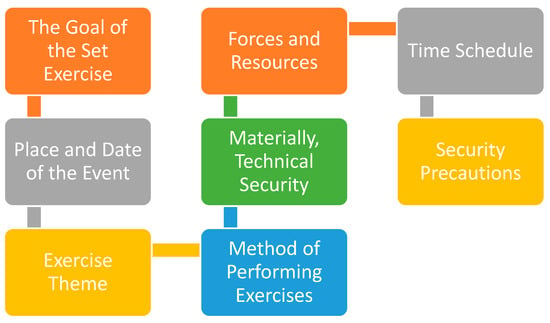
Figure 2.
Exercises plan.
This content is usually presented in paper form with attached graphics. To increase the effectiveness of the exercise and the creation of the preparatory phase, several planning tools are offered, which allow you to create an adequate plan for the preparation of tactical exercises [3,6].
In addition to the usual MS Office tools, it is possible to use other tools, for example, PRACTIS software. This programme allows the user to design and modify processes that can also be applied in the field of population protection, crisis management, and IRS. As Bartošíková, R. et al. [16] describe in their article, this is a programme that was developed by a private company, T-Soft, for the needs of the Faculty of Logistics and Crisis Management at Tomas Bata University in Zlin. However, this does not prevent its use in practice for the needs of the IRS and other public protection bodies.
Compared with text templates, this programme not only enables the creation of a complete scenario but also allows the addition of time intervals to individual events, their description, and the assignment of the participant’s role. The simulation is then validated by its applicability to real-life situations. Common tools do not provide these options; therefore, this programme becomes a market-leading tool that can be used effectively in creating exercises. A unique advantage is a choice between the graphic form or text form at the beginning of the simulation.
For use in the IRS, it is possible to simulate exercises according to typical activities for events, such as traffic accidents, fires, a person with a highly contagious disease, or a trapped explosive system, for which an example is created in the attached figures (Figure 3, Figure 4, Figure 5, Figure 6, Figure 7, Figure 8, Figure 9, Figure 10 and Figure 11).

Figure 3.
Scenario creation and graphical display of exercises.

Figure 4.
Tabular view.

Figure 5.
Overview of activities.
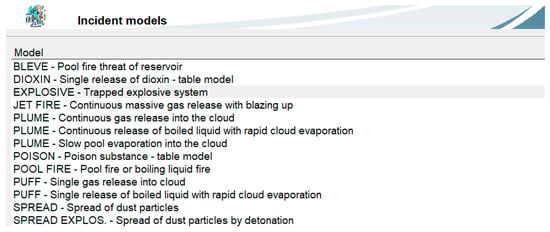
Figure 6.
Overview of incident models.

Figure 7.
Initial information about the scope of the event.
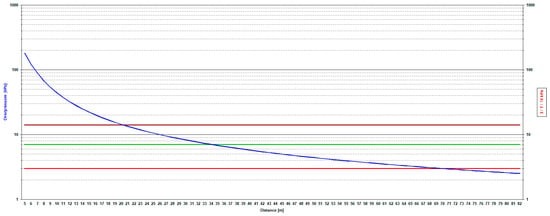
Figure 8.
Information about shock wave overpressure.
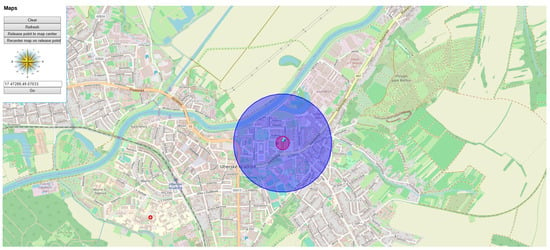
Figure 9.
TerEx output.
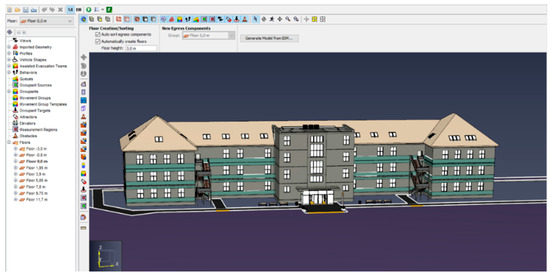
Figure 10.
Programme Pathfinder working environment.
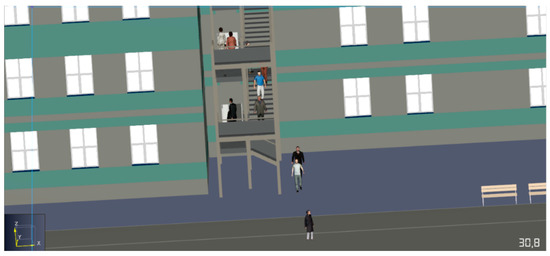
Figure 11.
Evacuation process.
The user can easily use the tabular view to add exercise participants and assign them their tasks during rescue and clean-up operations. The advantage is a clear system in which it is also possible to shape and re-sequence the processes and activities.
In addition to real-time, you can add game time and set a schedule for each event or progress. The game time can be simulated in the programme, and it can be checked whether all the procedures defined in the plan are or have been fulfilled.
Another possibility of use in planning IRS exercises is programme TERrorist EXpert (TerEx). This tool is mainly used to simulate the leakage of hazardous chemicals and explosives. Compared with PRACTIS, it does not offer so many functions, but the advantage is the overlay of geographic information systems, so the simulation can be overlayed directly on a base map. Both programmes then complement each other perfectly, so in the case of exercises focused on chemical substances, traffic accidents with leakage of dangerous substances, or explosions, they are ideal for connecting outputs. An output with a trapped explosive system was also used for the demonstration to show the interconnection of both programmes.
The outputs of the simulation include the necessary evacuation, which is shown on the map with the help of a slice. This information can be used to create an evacuation simulation in the programme Pathfinder, which will be mentioned in the next part of the article.
The output also includes a graph that determines the pressure of the shock wave. When creating exercises, this data can be used to determine the potential number of injured people around the scene.
Explanatory notes to Figure 8:
- Blue line—shock wave overpressure (kPa);
- Red line—shrapnel hazard;
- Green line—Threat to persons outside the building;
- Brown line—building damage.
The main output is a blast radius showing the epicenter of the explosion. The programme also allows the determination of the direction of the wind, which may affect the transport of hazardous substances in the air to some extent.
For the preparation of exercises in which the primary goal or at least part of it is the evacuation of people from buildings, the Pathfinder programme can be used. This programme allows you to load plans, for example, in CAD format, and create an evacuation procedure here. Qin, Ch., et al. [17] in their article deal with the application of this software in the evacuation of a metro station and describe the functions of this tool. The programme itself has numerous functions, but for the preparation of tactical exercises aimed at evacuation, their simulations are ample. Similar to the previous programme, PRACTIS and TerEx can relate to this as well.
In Figure 10 below, one can see the work environment in which the created school object is recorded.
In Figure 11, the course of the evacuation simulation along the evacuation staircase can be observed. The simulation can be viewed from all angles and the user can adjust the angle of view by simply moving the cursor.
A comparison table has been prepared for clarity. It contains basic information about individual software that was used for the preparatory phase of the IRS exercise.
Table 1 visually shows the comparison between the mentioned and proposed software tools for creating exercises in the preparatory phase. The table compares both the financial cost of individual tools and, for example, their time-related resource cost for training. For members of the IRS, the tools available for these software tools can also be decisive factors. For this reason, for example, map materials, mobile devices, and the possibility of inserting documents or creating scenarios are also compared. As stated earlier, all these tools are also suitable for interlinking.

Table 1.
Comparison of programme tools for the preparatory phase.
The resulting comparison table provides a closer comparison of the tools of individual software tools and the possibility of application for the creation and implementation of exercises.
3.2. Implementation Phase
The implementation phase takes place by announcing a simulated emergency according to the approved exercise plan and is completed by the implementation of rescue and clean-up operations by the involved IRS units.
Nowadays, there are many modern technologies for the implementation of exercises, which use a variety of software equipment. One of these technologies is virtual reality technology, which is gradually building its place in the IRS. According to V. Mach [18], virtual reality can be defined as “an advanced user interface that includes a simulation of a real environment in real-time, where the user interacts through several sensory channels (sight, hearing, touch, smell, and taste)”.
Exercises with the help of this technology do not have to take place in real situations, but with the help of simulators they can be embedded in the overall simulation and thus carry out the implementation of the exercises as they were determined in the preparatory phase. Virtual reality is predominant in the field of fire protection.
An example is the FLAIM Trainer, which is a configurable and mobile training system. This simulator simulates a realistic rendering of the effects of smoke, fire, water, and foam and corresponds exactly to the physical settings of the nozzles and power. It is thus possible to simulate the fire-fighting conditions that firefighters experience in real situations. Levin, Tamir, et al. [19] describe the possibilities of integrating a virtual reality platform with numerical simulation tools for reproducing a fire scenario and use FLAIM Trainer for this purpose.
To take advantage of virtual reality, it is necessary to have the right equipment. For these purposes, it is necessary to have hardware (PC) with VR support, a VR headset (e.g., HTC VIVE, OCULUS), and software (3D tools, Steam VR, and others). A preview of HTC Vive pro is shown in Figure 12.
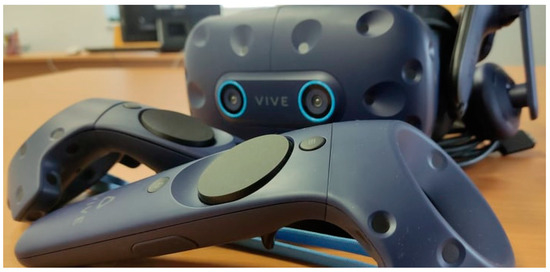
Figure 12.
HTC Vive Pro (Tchao-jüan, Tchaj-wan).
Another technology is augmented reality technology. Doerner et al. [20] define augmented reality as “the enrichment of reality with artificial virtual content”.
This technology can be used with smart devices (smartphones, tablets), or newer technologies in the form of headsets can be used. Similar to VR technology, AR is increasingly focusing on the use of headsets in the workplace, and so far, the headset seems to be the most sophisticated option. A suitable example can be considered Hololens 2 (Redmond, WA, USA) from Microsoft.
ARinVR: Bringing Mobile AR into VR, Zhang, et al. [21] emphasize the issue of screen size in smart devices. Although smart devices are among the most common platforms for AR, the size of the screens limits the use of this technology, even with limited performance and user experience.
For the area of IRS and exercises, this technology is offered for displaying simulations of events in which the IRS participates. It is also possible to use standard activities, which determine the procedures for rescue and liquidation work. One of the possibilities is, for example, to display the plan of the progress of the components at the intervention commander or the exercise schedule, where it would also be possible to take shots of the whole course using installed cameras in either a smart device or Hololens 2.
To take advantage of this technology, it is necessary to have the ARCore (version 1.34.222640233) application in the case of smart devices, which enables the display of elements of augmented reality. Unfortunately, not every smartphone or tablet has this feature. In Table 2, selected devices that have the ARCore function are mentioned. The complete list can be found on the developer’s site from Google [22].

Table 2.
Example of supported Android devices [22].
For iOS devices, ARKit (ARKit 5, version 1.0) is required, which is supported by all iOS devices 11.0 and higher. Examples of these devices are shown below (Table 3).

Table 3.
Example of supported iOS devices [22].
3.3. Evaluation Phase
The phase starts immediately after the end of the implementation phase. Evaluation reports are collected from the members of the judging team and subsequently by the start of the evaluation team, which is responsible for the overall analysis of the exercises, the elaboration of proposals, and the final evaluation. The stage itself ends with the handing over of the evaluation report to the authorized person who approved or ordered the exercise.
During the evaluation of the tactical exercise, emphasis is primarily placed on the nine points listed below, which are determined in the evaluation part according to the instructions of the director of the Fire Rescue Service of the Czech Republic.
- Receiving an alert, announcing a fire alarm, and leaving;
- Assessment of the technique used;
- Intervention organization and management;
- Deployment and use of fire equipment;
- Supplying deployed forces and resources with water and other materials;
- Passability of roads and logistics areas;
- Communication;
- Compliance with regulations on occupational safety and health protection;
- Discipline in intervention [23].
These areas are evaluated by the referees during the exercise and their results are subsequently projected into the evaluation part. All participating components of the IRS are later informed of these results, and further measures are taken based on their success. In connection with the created simulations, there is a space for the introduction of the 10th point, namely the fulfillment of exercises according to a predetermined simulation plan and time interval.
To evaluate the exercises, it is possible to use the output of the compared programme, which can be compared with the set goal and schedule that was defined in the preparatory phase.
These outputs can be included in the appendix part of the documentation, where an analysis of deficiencies in implementation and points that have not been met or complications that have been recorded will be performed.
4. Discussion
Exercises organized in cooperation with the components of the IRS are often determined from the experience and practices gained from previous exercises. They are often designed only in text form and, in any case, they are not further modified for simulations that can help in the creation.
The research presented in this article compared the possibilities of applying software support to individual phases of creating exercises. The article is divided into preparatory, implementation, and evaluation phases.
The possible use across technologies and use in practice was pointed out. The individual programmes were compared with each other and their pros and cons were highlighted. Almost no exercises for the components of the IRS use any software tools for the creation of exercises; therefore, this article pointed out the possible streamlining of their creation and application for individual components.
The limiting element of this article is the insufficient literary background devoted to the issue of organizing exercises of the components of the IRS and the connection with software applications. Researchers often deal with the possible use of one tool or one extraordinary event, such as Benvegnù, G. et al. [24]. This article points out the possible applicability of software tools to the individual phases of the implementation of the exercise and brings comparison of selected tools for the preparatory phase. Another case study is by Arias, S. et al. [25], where the authors apply virtual reality technology for fire evacuation purposes. The publications confirm the stated fact that only one specific event or IRS is always discussed, but no formal publication would compare the possible application and interconnection of other software applications for IRS exercises.
Managerial insights into individual levels of research are presented in Table 4.

Table 4.
Outcomes and managerial insights for Integrated Rescue System software tools.
Table 5 summarises the titles, authors, journals, central research questions, methods, and outcomes of each analysed paper. These compare the results achieved with other authors.

Table 5.
Research studies on the Integrated Rescue System software tools.
5. Conclusions
This article aimed to perform a comparison of the proposed software applications in the organization of exercises of the components of the IRS in the Czech Republic. Tactical exercises are an integral part of dealing with emergencies that people encounter daily. These exercises allow for better preparedness and, consequently, rescue and liquidation work. Facilitating these exercises within the organization of work brought possible proposals for the involvement of software applications. In the environment of the IRS, there are no publications or professional articles that focus on the organization itself, but only on the specific use of the technology, such as virtual reality, which is increasingly applied in the field of fire protection.
Insufficient literary elaboration of this issue is a limiting element in this article, but it allows for the continuation of the design of the organization and to put into specific exercises of the components. Future research is intended for the application of modern technologies, specifically augmented and virtual reality, which is one of the areas of interest for the development and components of an IRS. Specifically, virtual reality is already often applied to fire protection trends, for example, in evacuation simulations. Among the sources of the selected articles, we can mention Lorusso et al. [27] or Yang et al. [28] where the authors apply both technologies. In particular, the application of augmented reality to the evacuation design platform in the training game is described in the article by Catal et al. [29].
Concerning the knowledge found and published in this article, it can be stated that this issue is not sufficiently mapped and there is a lack of quality professional literature focused on this specific topic. Therefore, it is necessary to deal with this issue and publish the results in professional scientific journals.
Author Contributions
Three authors participated in the research presented in the article. The main author M.D. defined the issue of the IRS and analyzed the use of programmes for organizing exercises of the IRS with created models and simulations. The second author M.F. performed a comparative analysis of the established programmes. The last author L.S. determined the methodology of the article and participated in the correction of the submitted article. All authors have read and agreed to the published version of the manuscript.
Funding
This research was supported by the Internal Grant Agency of Tomas Bata University in Zlin under project no. IGA/FAI/2022/003, and the project: Application of advanced methods and tools of information technology in the process of civil protection (RVO/FLKŘ/2022/02, DKRVO).
Institutional Review Board Statement
Not applicable.
Informed Consent Statement
Not applicable.
Data Availability Statement
Not applicable.
Conflicts of Interest
The authors declare no conflict of interest. The founding sponsors had no role in the design of the study; in the collection, analyses, or interpretation of data; in the writing of the manuscript, and in the decision to publish the results.
References
- Czechia. Act No. 239 of 28 June 2000 on the Integrated Rescue System; Amount 73; Collection of Laws of the Czech Republic: Prague, Czech Republic, 2000.
- Vichova, K.; Hromada, M. Assessment of emergency supply of healthcare facilities as a module of the crisis management information system. MATEC Web Conf. 2018, 210, 02026. [Google Scholar] [CrossRef][Green Version]
- Collective of authors. Module–G: Integrated Rescue System and Fire Protection; Ministry of the Interior: Prague, Czech Republic, 2020; ISBN 978-80-7616-071-2.
- Haddow, G.D.; Bullock, J.A.; Coppola, D.P. Introduction to Emergency Management; Butterworth-Heinemann: Oxford, UK, 2020; ISBN 978-0-12-817139-4. [Google Scholar]
- Yusufalievich, M.S.; Maripjon, O.; Xakimov, O. Natural Emergency Situations and Protection of the Population from their Effects. Cent. Asian J. Theor. Appl. Sci. 2022, 3, 379–383. [Google Scholar]
- Firefighters Documentation. Fire and Rescue Service of the Czech Republic: Prague, Czech Republic. 2022. Available online: https://www.hzscr.cz/clanek/dokumentace-izs-587832.aspx?q=Y2hudW09NQ%3D%3D (accessed on 15 July 2022).
- LI, F. Intelligent Science Empowers: Building Fire Protection Technology Development. In Handbook of Cognitive and Autonomous Systems for Fire Resilient Infrastructures; Springer: Cham, Switzerland, 2022; pp. 93–116. [Google Scholar]
- Benda, L.; Kopecký, Z.; Pulpan, P. Basis for Improving Information Support of Crisis Managers’ Decision Making. In Proceedings of the 7th Scientific International Conference on Crisis Management: Environmental Protection of Population, Brno, Czech Republic, 13–14 June 2012; ISBN 978-80-86710-61-7. [Google Scholar]
- Stanek, S.; Drosio, S. Intelligent computer support for crisis management. Intell. Decis. Technol. 2013, 8, 53–63. [Google Scholar] [CrossRef]
- Çakıroğlu, Ü.; Seyfullah, G. Development of fire safety behavioral skills via virtual reality. Comput. Educ. 2019, 133, 56–68. [Google Scholar] [CrossRef]
- Guo, Y.; Zhu, J.; Wang, Y.; Chai, J.; Li, W.; Fu, L.; Xu, B.; Gong, Y. A Virtual Reality Simulation Method for Crowd Evacuation in a Multiexit Indoor Fire Environment. ISPRS Int. J. Geo Inf. 2020, 9, 750. [Google Scholar] [CrossRef]
- Xu, L.; Huang, K.; Liu, J.; Dongsheng Li, Y.; Chen, F. Intelligent planning of fire evacuation routes using an improved ant colony optimization algorithm. J. Build. Eng. 2022, 61, 105208. [Google Scholar] [CrossRef]
- Yu, X.; Yu, P.; Wang, C.; Wang, D.; Shi, W.; Shou, W.; Wang, J.; Wang, X. Integrating Virtual Reality and Building Information Modeling for Improving Highway Tunnel Emergency Response Training. Buildings 2022, 12, 1523. [Google Scholar] [CrossRef]
- Czech Republic. Population Protection Concept until 2025 with a View to 2030; MV-GŘHZS ČR: Prague, Czech Republic, 2020.
- Grabowski, A.; Jach, K. The use of virtual reality in the training of professionals: With the example of firefighters. Comput. Animat. Virtual Worlds 2020, 32, e1981. [Google Scholar] [CrossRef]
- Bartošíková, R.; Bilíková, J.; Strohmandl, J.; Šefčík, V.; Taraba, P. Modelling of decision-making in crisis management. In Proceedings of the 24th International Business Information Management Association Conference-Crafting Global Competitive Economies: 2020 Vision Strategic Planning and Smart Implementation, Milan, Italy, 6–7 November 2014; pp. 1479–1483, ISBN 978-098604193-8. [Google Scholar]
- Qin, J.; Liu, C.; Huang, Q. Simulation on fire emergency evacuation in special subway station based on Pathfinder. Case Stud. Therm. Eng. 2020, 21, 100677. [Google Scholar] [CrossRef]
- Mach, V.; Valouch, J.; Adamek, M.; Sevcik, J. Virtual reality—Level of immersion within the crime investigation. MATEC Web Conf. 2019, 292, 01031. [Google Scholar] [CrossRef]
- Levin, T.; Chessum, S.; Mullins, J.; Yoshihashi, N.; Hayashi, K. Ensuring Greater Safety for our Firefighters and Our Communities: Integrating FLAIM Trainer TM and hitoe TM. NTT Tech. Rev. 2019, 17, 24–31. [Google Scholar]
- Doerner, R.; Broll, W.; Grimm, P.; Jung, B. Virtual and Augmented Reality (VR/AR) Foundations and Methods of Extended Realities (XR); Springer: Freiberg, Germany, 2022. [Google Scholar] [CrossRef]
- Zhang, L.; He, W.; Liu, Y.; Zou, Q.; Bai, H.; Billinghurst, M. ARinVR: Bringing Mobile AR into VR. In Proceedings of the Computer Graphics and Interactive Techniques Conference, Virtual, 9–13 August 2021; p. 2. [Google Scholar] [CrossRef]
- ARCore Supported Devices. Google. 2022. Available online: https://developers.google.com/ar/devices (accessed on 15 July 2022).
- Czech Republic. Instruction of the Director General of the Fire and Rescue Service of the Czech Republic of 3 February 2009: Laying down the Procedure for the Preparation and Conduct of Screening and TACTICAL exercises; Fire and Rescue Service of the Czech Republic: Prague, Czech Republic, 2009.
- Benvegnù, G.; Furlan, M.; Orso, V.; Gamberini, L. The Role of Virtual Spaces and Interactivity in Emergency Training. In Proceedings of the European Conference on Cognitive Ergonomics 2021 (ECCE 2021), Siena, Italy, 26–29 April 2021; Volume 5, pp. 1–5. [Google Scholar] [CrossRef]
- Arias, S.; Wahlqvist, J.; Nilsson, D.; Ronchi, E.; Frantzich, H. Pursuing behavioral realism in Virtual Reality for fire evacuation research. Fire Mater. 2020, 45, 462–472. [Google Scholar] [CrossRef]
- Popov, O.; Kyrylenko, Y.; Kameneva, I.; Iatsyshyn, A.; Andrii, I.; Kovach, V.; Artemchuk, V.; Bliznyuk, V.; Kiv, A. The use of specialized software for liquid radioactive material spills simulation to teach students and postgraduate students. CTE Workshop Proceedings. 2022, 3085, 306–322. [Google Scholar] [CrossRef]
- Lorusso, P.; De Iuliis, M.; Marasco, S.; Domaneschi, M.; Cimellaro, G.P.; Villa, V. Fire Emergency Evacuation from a School Building Using an Evolutionary Virtual Reality Platform. Buildings 2022, 12, 223. [Google Scholar] [CrossRef]
- Yang, L.; Liang, Y.; Wu, D.; Gault, J. Train and Equip Firefighters with Cognitive Virtual and Augmented Reality. In Proceedings of the IEEE 4th International Conference on Collaboration and Internet Computing (CIC), Philadelphia, PA, USA, 18–20 October 2018; pp. 453–459. [Google Scholar] [CrossRef]
- Catal, C.; Akbulut, A.; Tunali, B.; Ulug, E.; Ozturk, E. Evaluation of augmented reality technology for the design of an evacuation training game. Virtual Real. 2020, 24, 359–368. [Google Scholar] [CrossRef]
Publisher’s Note: MDPI stays neutral with regard to jurisdictional claims in published maps and institutional affiliations. |
© 2022 by the authors. Licensee MDPI, Basel, Switzerland. This article is an open access article distributed under the terms and conditions of the Creative Commons Attribution (CC BY) license (https://creativecommons.org/licenses/by/4.0/).